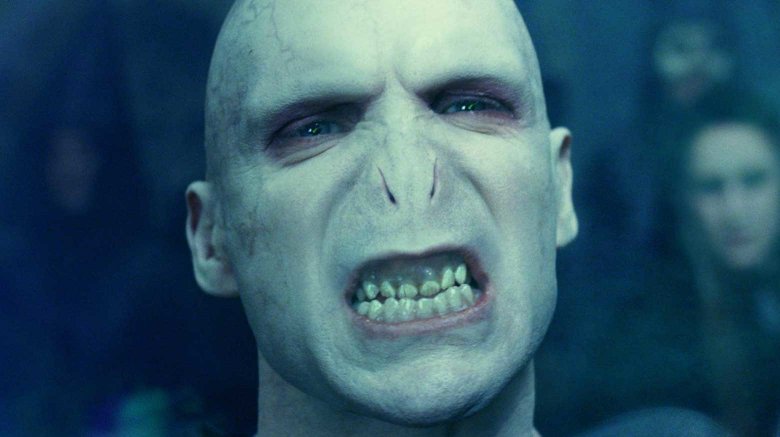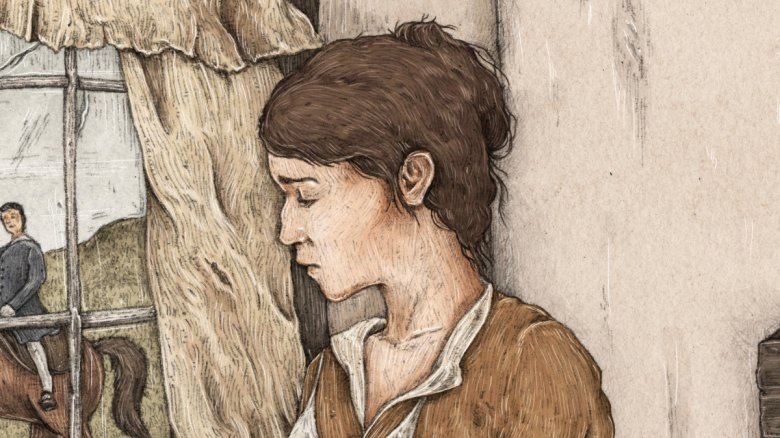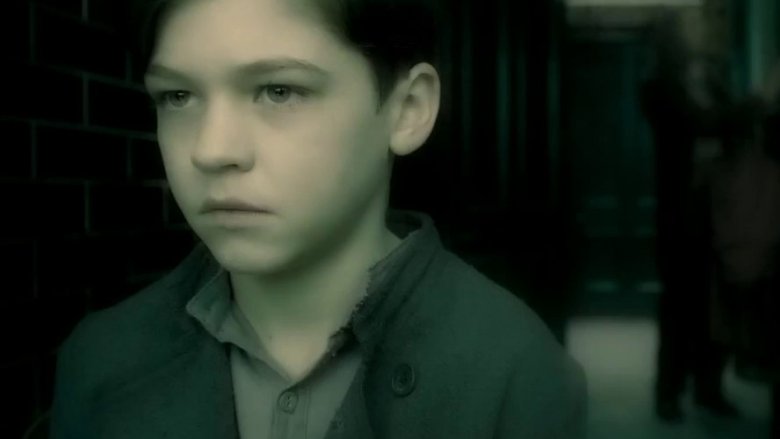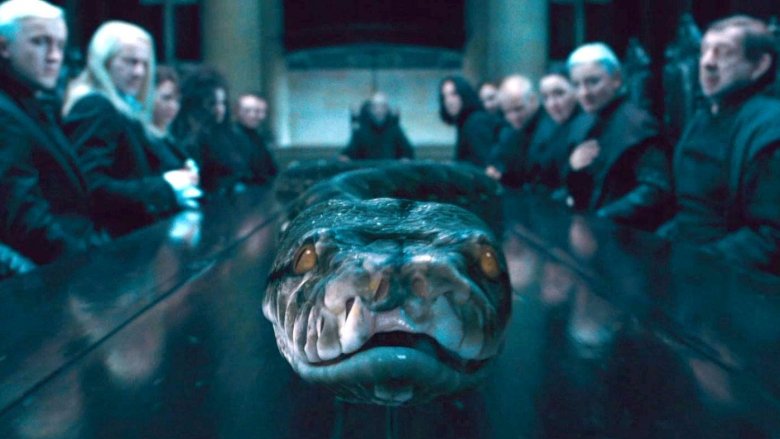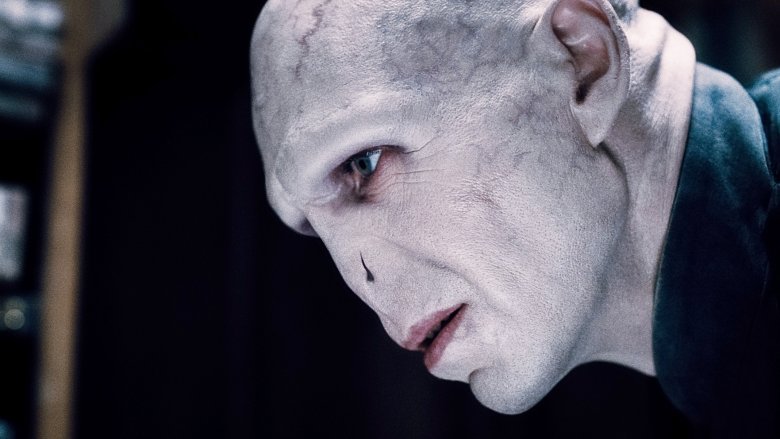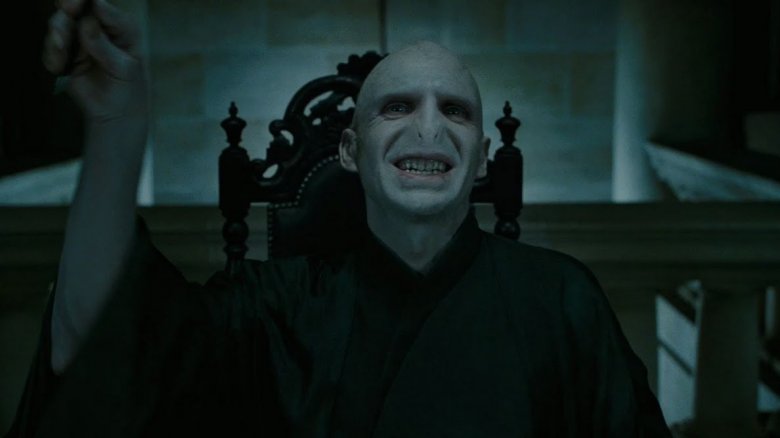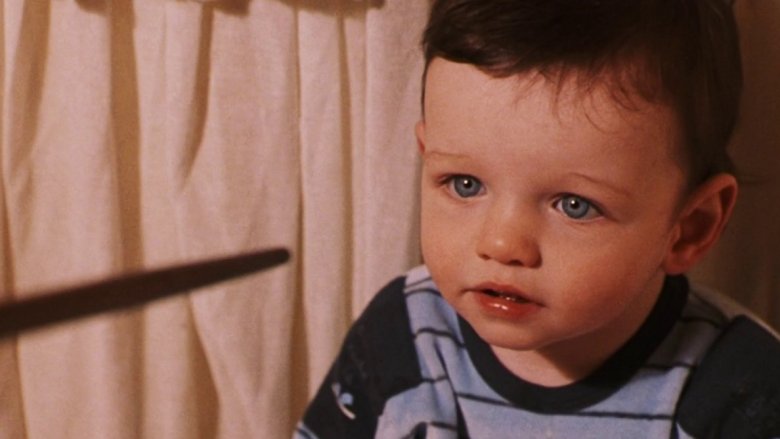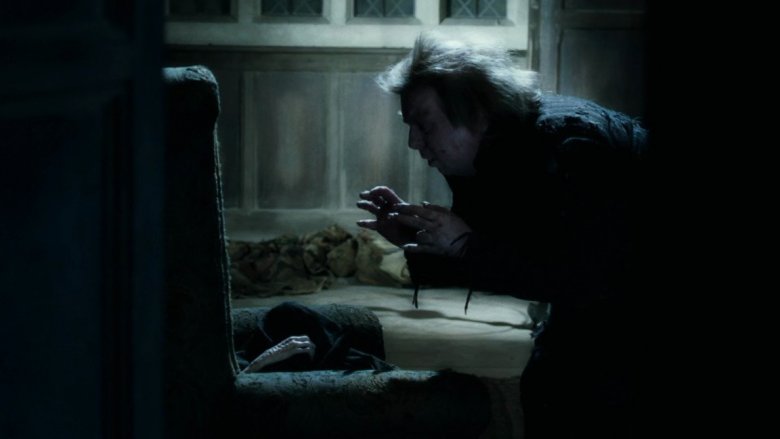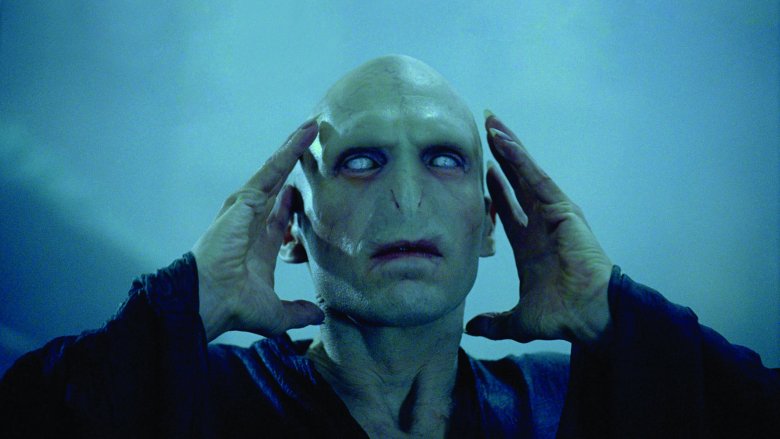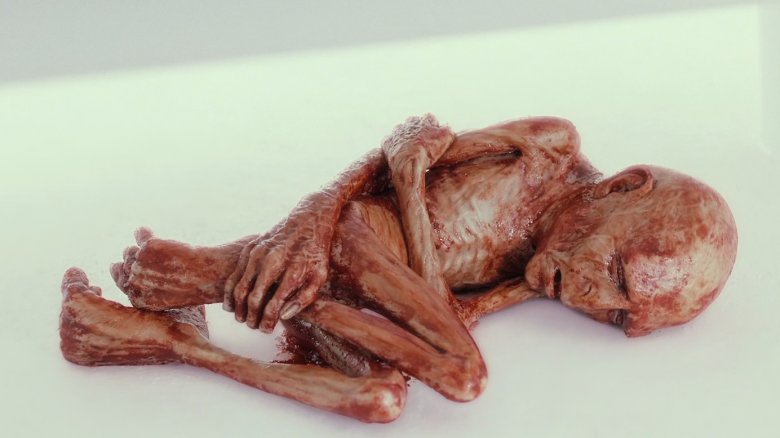Voldemort's Disfigured Face Explained
The Dark Lord, He-Who-Must-Not-Be-Named, You-Know-Who — whatever you call him, you know who Voldemort is. The murderous wizard who just can't seem to kill Harry Potter once and for all is a cultural titan and an icon of evil. He menaced the crowds of the 2012 London Olympic Games opening ceremony as an enormous, billowing puppet, only to be defeated by a flock of Mary Poppinses. The Lego Batman Movie herds him into the Phantom Zone alongside The Wizard of Oz's Wicked Witch of the West, her flying monkey, and Doctor Who's Daleks. He has become synonymous with dastardly doings, venomous bigotry, and outright terrorism. Given the fact that Harry Potter only becomes more cemented as an international touchstone with every passing year, that's not likely to change any time soon.
Part of what makes Voldemort so memorable is his uniquely alien look. He's tall, skeletal, pale as chalk, without any discernible body hair, and most crucially, without a nose. In its place are two reptilian slits that render him profoundly less human in appearance — which is exactly what he wants. How did the man who was once handsome enough to, quite literally, get away with murder, transform himself into an avatar of evil? Join us as we plummet into the depths of You-Know-Who's magical malfeasance, and the toll it took on his looks.
A handsome father and an unfortunate mother
The man who would become Voldemort came from two vastly different lineages. His father was a patrician heir, born to the wealthy Riddle family of Little Hangleton. An only son, Tom Sr. was, according to his neighbors, quite the snob. He and his parents were accordingly disliked, but that didn't seem to matter much in the grand scheme of things: they were blue-blooded landowners, and he was widely known as handsome. His tall, dark looks had already netted him a paramour, described only as a young woman named Cecilia, when Voldemort's mother became besotted with him.
Merope Gaunt, in contrast to the man she had fallen for and the son she would go on to bear, was deeply unattractive. The result of generations of inbreeding, she was a neglected wretch with a lazy eye, a "plain, pale, rather heavy face," and a cringing, defeated demeanor. Merope had likely lived her entire life under the thumb of her father and brother, slave to the former's ideals of blood purity and target of the latter's cruelties. It's no wonder that she found herself attracted to the beautiful young man who rode past their cottage — but the lengths to which she went to put him under her literal spell were shocking. After Tom Sr. emerged from the mind-controlling haze Merope had cast, she fled, gave birth to Tom Riddle Jr., and prayed that he'd look like his father before she passed away.
Taking after his father
Merope's wish was granted: Tom Riddle Jr. grew into a handsome young man. Though he never explicitly acknowledged this fact, the moments of his past that Harry and Voldemort observe through the Pensieve made it clear that he understood how to use his compelling looks as a tool. How early this started cannot be known, but it seems likely that it began when he was young — potentially even before he knew of the magical world.
When Dumbledore visited Wool's Orphanage to meet the promising young lad, he learned quickly of the boy's odd behaviors. The matron spoke warily of him, saying that he "[frightened] the other children," and that certain violent tendencies were indicated. She couldn't prove that Tom Riddle had murdered another boy's rabbit, nor what had happened in the cave he lured two children to that rendered them "funny ... never the same again," but she knew enough to be concerned. Regardless, the fact that these offenses had happened more than once implies that something about the strange little boy with the terrifying habits kept drawing new and gullible victims. Tom might not have enjoyed the fact that his good looks were an inheritance from his shamefully non-magical father, but that doesn't mean he wasn't willing to use them to further his depraved aims.
A growing affinity for snakes
Growing up in a world without magic was a defining experience for Voldemort. He wasn't just surrounded by what he would go on to view as the mundanities of the muggle world, he was trapped at one of the lowest and most pitiable levels of it: an early 20th-century orphanage. He was alone, with no one to guide him but distant matrons and teachers whose intelligence did not match his own. Sure, he could probably tell he was uncommonly clever and good-looking from an early age, but given how fervently he proclaimed to Dumbledore that he knew all along that he was "special," it is likely that his sense of self was bigger than even those formidable talents.
He was not, however, without any magical experiences during this time. As he told Dumbledore upon learning of his abilities, he had already been speaking to snakes for some time. In a life as lonely as his had been, this was probably a great comfort, in addition to being a confirmation of the greatness he so dearly wanted to embody. Snakes were friends, proof of his special talents, and could be coerced into doing his bidding. Years later, Voldemort would disfigure himself in a strikingly snake-life way, transforming his nose into flat, colorless slits and ridding himself of hair. He didn't just want to inspire fear — he wanted to honor the creatures he'd felt an affinity towards for decades.
Handsome Tom Riddle
Tom Riddle's attractive looks, with the help of his keen mind and manipulative prowess, made him quite the star during his years at Hogwarts. Awards, accolades, and admiration flowed towards him from teachers and students alike — only Dumbledore, as he later noted, was unmoved and prone to keeping an "annoyingly close watch" over his activities. It is here that the seeds of Voldemort's reign of terror were planted: peers who would become Death Eaters were charmed, professors were pumped for obscure knowledge about the pursuit of immortality, and early feats of Dark Magic, most notably the opening of the Chamber of Secrets and the creation of his first horcruxes, were performed.
Thus established, Tom Riddle joined Knockturn Alley business Borgin and Burkes upon graduation. In perhaps his most blatant use of his handsomeness, he seduced Hepzibah Smith, a wealthy old woman who owned a locket of Salazar Slytherin's and a cup of Helga Hufflepuff's he would go on to make into horcruxes. As Harry and Dumbledore observed with the Pensieve, he brought the giggly Smith flowers, laid on the flattery, and played up his interest in her collection of artifacts. Her subsequent murder by poisoning resulted in two horcruxes — all thanks to his alluring smile and a choice few compliments.
"Waxy and oddly distorted"
Years passed, and during them, Tom Riddle assumed the mantle of Lord Voldemort. Innocents were murdered, horcruxes were made of their senseless deaths, and sometimes, even their empty corpses were pressed into service as Inferi. Specifics as to what depths of dark magic Voldemort sank to are scarce here, but what is known is horrifying.
Most suggestive of the extremes to which he went is the manner in which his appearance changed. Ten years after Hepzibah Smith's murder, Riddle (who was still using his birth name in polite society) emerged to ask Dumbledore, already Headmaster of Hogwarts, for the position of Defense Against the Dark Arts professor. As he argued, by that time he had "experimented ... pushed the boundaries of magic further, perhaps, than they have ever been pushed." This had begun to wear away at his looks: Harry noted from his viewpoint in the Pensieve that Riddle looked "as though his features had been burned and blurred; they were waxy and oddly distorted, and the whites of his eyes now had a permanently bloody look ... his face was as pale as the snow glistening on his shoulders." The implication that Voldemort's evil was strong enough to erode his good looks is startling enough — worse still is the fact that Voldemort had grown so powerful that he no longer felt the need to maintain his handsomeness as a tool.
Experiments in dark magic
Dumbledore, of course, did not make Voldemort a professor. With this last vesitge of attachment to the straight and narrow path of magic worn away, Voldemort plunged into terrorism and arcane wizardry. Here lie the beginnings of the First Wizarding War: campaigns of murder, the infiltration of the halls of the powerful, and the scarring of the magical world that would leave its inhabitant too terrified to even speak his name for years to come. Giants, werewolves, and all manner of dark creatures were recruited to his side. His horcruxes were secreted across the country, from the diary Ginny Weasley would become possessed by to the locket in the cave Dumbledore and Harry would one day visit.
It was a grave time for the world, but an absolute apex of power for Voldemort. It is during this time that the last of his comely appearance would desert him. His experiments with dark magic, his bloody trail of murders, and his utterly ruthless control of his followers (and those enchanted into servitude) resulted in the bone-white wraith he became. Voldemort appeared to be less a man than a cold-blooded creature of nightmares, with scarlet eyes, a skeletal frame, and hands "like large, pale spiders." He'd managed to make himself into a being of his own invention, a mixture of traits borrowed from reptiles, monsters of legend, and mythologized tyrants. He'd grown to look as inhuman as his acts, and that was exactly according to plan.
Reduced to a bodiless spirit
As fans know, the killing curse Voldemort cast upon little Harry Potter rebounded upon him, latching the splintered shard of his soul onto the infant and rendering Voldemort "less than the meanest ghost." He was not actually dead, as so many witches and wizards went on to believe, but he came very close to it. Tethered to life by his horcruxes, he had become a formless spirit unable to speak, let alone use magic in any significant way.
It was during this time that Voldemort fled to the forests of Albania. His followers, to his rage and surprise, abandoned him, save those who went to Azkaban. Their loyalty would eventually be rewarded, but for over ten years it was utterly useless. His sole remaining power was the ability to possess other creatures. Snakes were his preference, but his inhabiting of their meager bodies shortened their lifespans considerably. Possessing a human was out of the question, as aurors were still abroad and looking for him. He was at his most powerless in this era, and years later, he would describe it as a period of despair and hopelessness. Just when all seemed lost, into the forest wandered Professor Quirrell. A gullible man bound for Hogwarts, he'd nearly come gift-wrapped for Voldemort's purposes. Though he could only manifest as a face on the back of Quirrell's head, Voldemort had regained a body, and with it, a sense of purpose.
A rudimentary body
Voldemort's time with Quirrell came to an end, of course. Harry Potter, ever the hero, drove him from the hapless professor's body and into the shadows once more. But this time, Voldemort wouldn't be confined to the nooks and crannies of the world for a decade. This time, he found help.
Peter Pettigrew, the man who betrayed Harry's family for the sake of the Dark Lord's favor, found his master once more in the forests of Albania. Though Pettigrew was a cringing coward, he proved critically important to Voldemort's plans. Using snake venom and unicorn blood, the two concocted a rudimentary body for Voldemort to inhabit. Harry, upon seeing it at the climax of Goblet of Fire, describes it as "ugly, slimy, and blind ... [it] had the shape of a crouched human child, except that Harry had never seen anything less like a child. It was hairless and scaly-looking, a dark, raw, reddish black. Its arms and legs were thin and feeble, and its face — no child alive ever had a face like that — was flat and snake-like, with gleaming red eyes." It was in this feeble form that Voldemort lived for roughly a year, planning his infiltration of the Triwizard tournament, hiding Alastor Moody away in his own enchanted trunk, and learning of his followers' exploits at the Quidditch World Cup. He was shrunken and weak, to be sure — but not for long.
The Dark Lord returns
Though Voldemort did not succeed in murdering Harry Potter, he did accomplish everything else he'd set out to do that fateful night in the Little Hangleton graveyard: he gathered his followers, reasserted his command, and regained his body through a rite of dark, blood-based magic.
"Bone of the father, unknowingly given" was taken from his father's moldering grave. "Blood of the enemy, forcibly taken" came from Harry's imprisoned arm. "Flesh of the servant, willingly sacrificed" arrived from Wormtail himself, who cut off his own hand for the sake of his master. Voldemort, still infantile, was lowered into a potion made from these macabre ingredients. From it, he emerged as the man he had been: "Whiter than a skull, with wide, livid scarlet eyes and a nose that was flat as a snake's but with slits for nostrils." He was tall and thin, his fingers long and spindly, his voice grown high and cold. Robed in black by the ever-slavish Pettigrew, he strode once more among his Death Eaters and forced Harry to duel him — unwisely, it turned out, as Harry escaped back to Hogwarts using the Portkey that had brought him to the graveyard. This was a disappointment to be sure, but a passing one. Voldemort had his freedom of movement back, his ability to perform magic restored, and his intimidating figure re-established. Though few knew it until the following year's battle in the Ministry of Magic, the Second Wizarding War had begun.
An eternity in limbo
Three years of terror ensued. Friends, leaders, and innocents fell to the Death Eaters. Hogwarts went from the safest place in the wizarding world to an active battleground. Harry, Ron, and Hermione went on the run, broke into Gringotts Bank, and nearly came to blows during the endless hunt for horcruxes. Finally, the war came to an explosive end. By preserving Harry' blood within his body, Voldemort had unknowingly kept Lily Potter's protective love alive. Combined with the mastery of the Deathly Hallows Harry had garnered, this caused Voldemort's final killing curse to rebound upon himself. He died, as he had always feared, like any other mortal man.
As Harry discovered in limbo with Dumbledore, however, Voldemort's afterlife was anything but typical. While others who died went onto to something greater and more definite, Voldemort was trapped forever as a stunted, "flayed-looking" child, unable to do much beyond suffering. As Dumbledore explained, though he presented a pitiable sight, he was beyond help due to the mangling he had put his own soul through. Gone forever was tall, handsome Tom Riddle. Out of reach was the skeletal figure of Lord Voldemort, the man whose horrific features were of his own design. Now, forever, lay nothing but an abused child, condemned to weakness and vulnerability in the waystation between life and death. Voldemort had sown the seeds of his own destruction, and now he had eternity to reap its bitter harvest.
